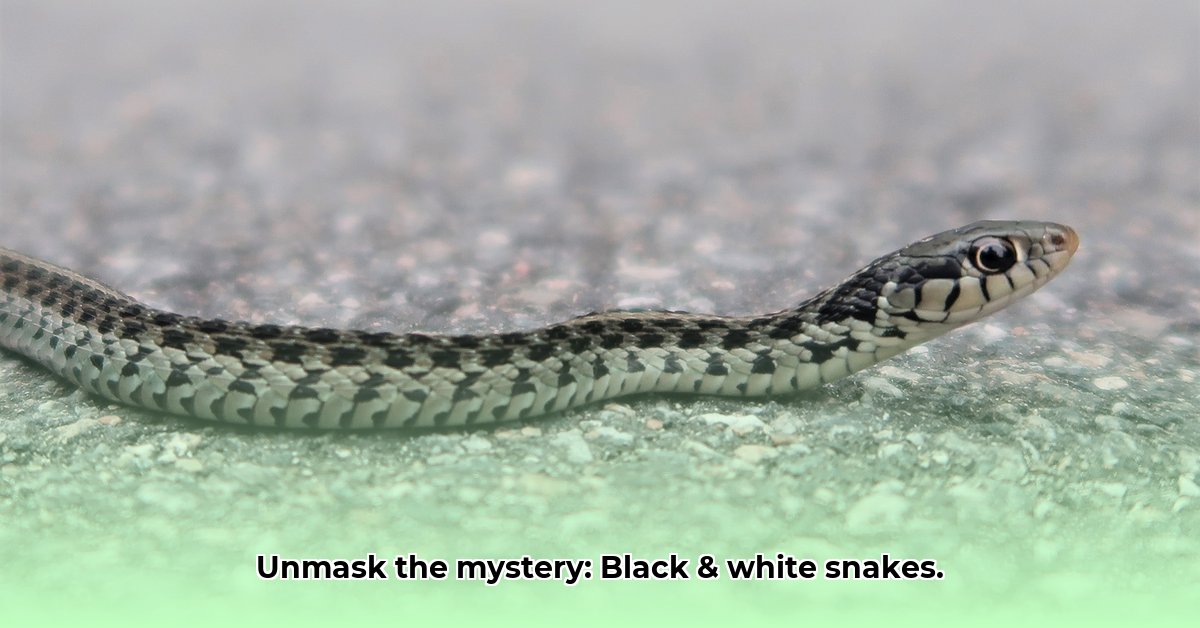
Black and White Snake Identification: A Comprehensive Guide
Many snakes boast striking black and white patterns, but this coloration alone doesn't reveal whether a snake is venomous. This guide provides a step-by-step approach to safe and accurate identification, suitable for novices and experts alike. We'll explore key characteristics, regional variations, and crucial safety precautions. For more images and information, see this helpful guide.
Understanding the Diversity of Black and White Snakes
Black and white snakes inhabit diverse ecosystems worldwide, exhibiting a fascinating array of patterns—from bold stripes to intricate spots. This guide focuses on safe identification, emphasizing that color is not a reliable indicator of venom. Accurate identification is crucial for safe observation and responsible interaction.
Step-by-Step Identification: A Practical Approach
Accurate identification requires a methodical approach focusing on easily observable characteristics.
1. Head Shape: Observe the head shape from a safe distance. A triangular head often (but not always!) indicates a venomous species, while a rounded head typically suggests a non-venomous snake. Use binoculars or a telephoto lens for closer observation without approaching the snake. Remember, head shape alone is not conclusive.
2. Body Patterns: Carefully examine the arrangement of black and white markings. Are they in distinct bands, blotches, or a more complex pattern? Detailed pattern descriptions and photographs (ideally from a reputable field guide) are essential for accurate identification.
3. Size and Build: Estimate the snake's length and body thickness from a safe distance. Use binoculars or zoom lenses to avoid getting too close. Size can help narrow down possibilities, but it isn't a definitive identifier.
4. Geographic Location: Knowing the snake's location significantly helps narrow down the potential species. This is critical as different regions harbor different species.
5. Utilize Field Guides: High-quality field guides are indispensable tools, providing detailed photographs, descriptions, and range maps to facilitate accurate identification. These guides are your best resource for confident identification.
Common Black and White Snake Profiles: A Regional Overview
(This section would include detailed species profiles with high-quality images, habitat preferences, venom status (with severity level if applicable), and geographical ranges. Due to space constraints, only one example is provided below.)
Example: Western Massasauga Rattlesnake ( Sistrurus catenatus tergeminus)
- Appearance: Dark brown and white crossbands on a darker background; relatively short, stocky body; triangular head; presence of a rattle.
- Habitat: Grasslands, wetlands.
- Venom: Highly venomous.
- Geographic Range: Central and Midwestern United States.
Prioritizing Safety: Observing Snakes Responsibly
Never handle a snake unless you are a trained professional. Observe from a safe distance, using binoculars or a telephoto lens. Maintaining a safe distance is paramount for your safety and the well-being of the snake.
In Case of a Snakebite: Seek immediate medical attention. Note the snake's appearance (safely—a photograph from a distance is ideal), as this information is vital for treatment. Time is crucial in snakebite emergencies.
Conservation: Protecting Black and White Snakes
Many black and white snake species face threats from habitat loss and human activities. Support conservation efforts by respecting their habitats and promoting responsible environmental stewardship.
Further Resources: Expanding Your Knowledge
Numerous resources are available for learning more about snake identification and conservation. Websites and field guides offer invaluable information. Consult reputable sources to ensure accuracy.
Venomous Black and White Snakes: Identification and Safety
Identifying venomous black and white snakes requires careful attention to detail and a cautious approach. While color is not a definitive indicator, certain features can increase the likelihood of encountering a venomous species.
Key Visual Characteristics of Venomous Snakes
While no single characteristic reliably distinguishes venomous from non-venomous black and white snakes, a combination of visual cues can increase your ability to assess the potential risk:
Triangular Head: Many (but not all) venomous snakes exhibit a distinctly triangular head shape. This is often, but not always, a warning sign.
Vertical Pupils (Elliptical): Some venomous snakes, particularly pit vipers, have vertical, slit-like pupils. However, this isn't a universal indicator.
Heat-Sensing Pits (Pit Vipers): Pit vipers, a group of venomous snakes, possess heat-sensing pits located between the eyes and nostrils. These pits assist in prey detection.
Scale Patterns: Specific scale patterns can be indicative of certain venomous species. Careful examination and comparison with field guides are essential in assessing this feature.
Body Build: Some venomous snakes are more robustly built than non-venomous species. This feature can be helpful but needs to be considered in context with the other features outlined above.
Safe Handling and Observation: A Crucial Reminder
Remember, the safest approach is to maintain a safe distance from all snakes. Do not attempt to handle any snake unless you are a trained and experienced herpetologist. Approach and handling of venomous snakes should only be undertaken by appropriately trained individuals employing the proper safety measures and equipment.
Continuing Education: Resources for Identification
Continue learning about snake identification through reputable field guides, online resources, and educational programs. This ongoing learning process is critical for safe and responsible interaction with these fascinating creatures.